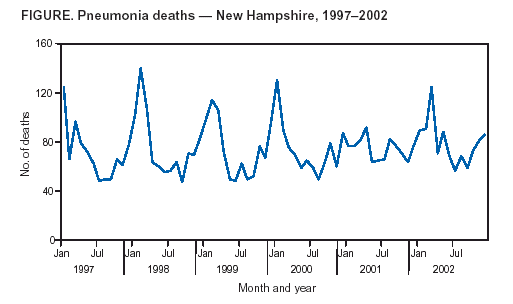 |
|
|
|
|
|
|
| ||||||||||
|
|
|
|
|
|
|
||||
| ||||||||||
|
|
|
|
|
Persons using assistive technology might not be able to fully access information in this file. For assistance, please send e-mail to: mmwrq@cdc.gov. Type 508 Accommodation and the title of the report in the subject line of e-mail. Death Certificate Surveillance --- New HampshireKim K. Fallon, D. Boone
Corresponding author: Kim K. Fallon, New Hampshire Department of Health and Human Services, 29 Hazen Dr., Concord, NH 03301. Telephone: 603-271-4820; Fax: 603-271-0545; E-mail: KFallon@dhhs.state.nh.us. AbstractIntroduction: New Hampshire is one of the only states in the United States that uses Vital Records Vision 2000, a system in which death certificates are filed electronically with the Division of Vital Records within 24 hours of being signed by a physician. The average time between date of death until certificates are filed with the state is 2.37 days. A surveillance coordinator reviews death certificates daily. Objectives: This surveillance system is designed to detect clusters of deaths, deaths considered unusual, and deaths relevant to public health. Methods: A query was developed that details >50 illnesses potentially related to terrorism. When an unusual death or cluster of deaths is found, the surveillance coordinator contacts the health-care provider to obtain more information. The state's communicable disease control unit investigates if warranted. Results: Three unusual deaths were identified in 2003. None had been reported to public health authorities. Two previously healthy young persons were hospitalized with undiagnosed pulmonary infections, one for 7 days and the other for 11 days, before death. Specimens from both patients were retrieved and sent to CDC for further testing. In addition, infectious encephalitis was listed as the cause of death for an older patient suspected of having West Nile virus; specimens were obtained and sent to the New Hampshire Public Health Laboratory, where West Nile virus was ruled out. In addition, a review of death-record data for the period 1997--2002 demonstrates a consistent trend in pneumonia deaths over time (Figure). Conclusions: Death certificate surveillance is able to 1) identify deaths that should have been, but were not, reported to public health agencies; 2) confirm the presence or absence of cluster deaths; 3) provide timely information on deaths statewide; and 4) provide information on seasonal trends in disease and death. Figure  Return to top.
Disclaimer All MMWR HTML versions of articles are electronic conversions from ASCII text into HTML. This conversion may have resulted in character translation or format errors in the HTML version. Users should not rely on this HTML document, but are referred to the electronic PDF version and/or the original MMWR paper copy for the official text, figures, and tables. An original paper copy of this issue can be obtained from the Superintendent of Documents, U.S. Government Printing Office (GPO), Washington, DC 20402-9371; telephone: (202) 512-1800. Contact GPO for current prices. **Questions or messages regarding errors in formatting should be addressed to mmwrq@cdc.gov.Page converted: 9/14/2004 |
|||||||||
This page last reviewed 9/14/2004
|